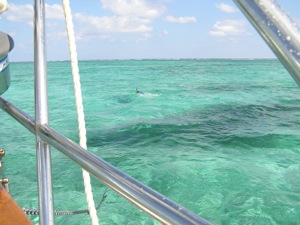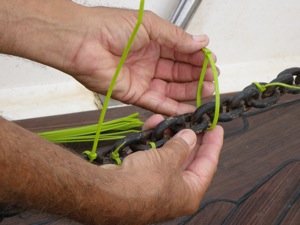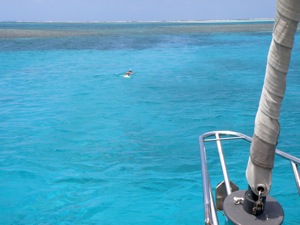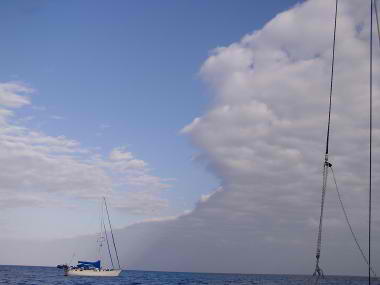So we all know anchoring in for a norther or squall line requires more attention than everyday anchoring. But boats drag every day, not necessarily in a norther. And sometimes a boat that’s been anchored in a spot for over a week drags when the wind pipes up! Why? You’d think the anchor would have sunk out of sight. But not necessarily. And why is it that boats rarely drag during daylight hours?
I remember one of our scariest incidents – we’ve only drug twice, that I can remember … but one of the incidents was inside the reef at Turneffe Atoll, Belize (the other was at Colson Caye Belize). Turneffe was the scariest by far. A friend was anchored somewhere behind us, a ways back, but in the black of the storm with rain driving sideways blinding us, who knew WHERE back there. Trying to get the ground tackle up and keep from running into another boat (only one other boat in the anchorage and we were not close together, but still…) made for a very scary few minutes. What should we have done differently? In both cases, we weren’t happy with the anchor – it wasn’t dug in as well as we would have preferred, but the bottom was thin sand over hard rock – far from ideal holding. In both cases, we should have kept moving until we found a patch of sand large enough to bury the anchor and not accepted “just OK”. So with that:

1. Arrive in plenty of daylight – ideally between noon and 2 PM. This gives you the highest sun on the water to allow you to see any lurking dangers beneath the water. The other benefit is that you have time to move to a different anchorage if for whatever reason the first one isn’t OK. Too many boats, can’t get the anchor to set correctly, whatever.
2. Pick your spot. There’s no hurry – we learned to drive slowly around the anchorage looking at all the available spots before selecting ours. Make sure the spot you select is far enough away from the other boats. Because you don’t know how much rode the other boats have out, imagine more rather than less – try to visualize what would happen in an abrupt wind shift in the middle of the night. Our rule of thumb is if we can throw an egg and hit another boat, we’re too close! This “rule” works both ways though … if another boat comes in and anchors too close – remember it’s your HOUSE that you’re protecting and it’s not impossible to say something constructive and nice as opposed to mean and rude like “you IDIOT, really??”. Oft times there are more adjectives attached. While you’re selecting a spot, if someone’s standing on their bow with their hands on their hips and they don’t appear ready to invite you over for cocktails at sunset, you might want to question whether you’re anchoring too close.
3. Anchor down! Put out some scope and let it settle in while admiring the view around. Once it’s settled put out more scope and gently back it down (no full reverse throttle yet). If it’s moving, bring it up and move. If it appears to be holding, move on to #4.

4. Dive or snorkel on it to see what’s up down there. If it’s laying on it’s side, you may need to hand set it – the object is to get it started digging in — wriggle the tip into the bottom as much as you can by hand.
5. Now’s the time to add the nylon snubber – the windlass should NOT take the load when you’re backing down. You’ll ruin an expensive piece of equipment. Once the snubber is tied off on both sides and extra chain dropped so that the chain is slack and the nylon rode snubber is taking the shock we move on to #6.
6. Now back down hard – we use full reverse throttle, but about 500 rpms at a time — David will say “give me 1000 rpms” and he’ll watch, then 1500 rpms, then 2000 and finally full reverse. If it moves, we start over. The anchoring drill can be frustrating when you can’t get it to set. Some criticize us for running up the rpms so high that we’ll pull it out. On the other hand, wouldn’t we rather pull it out now than in the middle of the night in a storm?
7. Anchor set, now it’s time to pay attention to the rode. Less than adequate scope is probably the primary reason boats drag. #2 is probably failure to set the anchor and check it to make sure it’s well dug in. In circumstances where you’re anchoring in a river or mucky dirty water deep enough that you can’t physically check it, it’s even more important to back it down hard and make SURE you’re not going anywhere.
Back to scope … err on the side of too much rather than too little. Mark your chain or rode so you KNOW how much you have out, you’re not just guessing. We usually have 7-1 out – be sure to include the distance to the bow from the water. And if we’re expecting bad weather, we’ll have more like 10-1, unless the anchorage is too crowded, either from other boats or reefs/rocks/obstructions.

8. Let it settle a few minutes while you attend to other boat chores – the sails should be put away and covered, electronics turned off and covered, aboard Winterlude we put the shade connector back between the bimini and the dodger, launch the dinghy, whatever; then check bearings and take GPS coordinates. We write them down – see the SAIL Magazine article “The Exit Strategy” for more.
I’m constantly amazed at boats that pull in, throw down maybe 20 feet in 8 feet of water, jump in their dinghy and off they go. What’s wrong with having lunch or a snack, relaxing in the cockpit an hour or even two before you jump off the boat to go explore? We have a “rule” that we never leave the boat within one hour of anchoring – mostly it works, sometimes extenuating circumstances preclude the “rule” but we try.
Do you do “everyday anchoring” differently? Leave a comment and share! THX! Jan














After dropping and securing your anchor, it’s always advisable to take a 3 point fix from the cockpit. I usually line up 3 lateral reference points within a 270 degree sweep of the shore.
For instance sight a rock that may line up with a building. Another fix could be a tree on the foreshore that lines up with another tree on a bank or hill behind it etc. Once you have sighted these 3 fixes, make a coffee, chill out and recheck the fixes after 30 mins or so, see what changes, you’ll soon know if the anchor is drifting. Recheck these references especially if the wind comes up.
Good advice John. We do it the old fashioned way ourselves. It’s always nice if you can use reference fix objects that can be seen at night, although in most of our favorite anchorages, far from civilization, it’s not always possible. Thanks!
I will turn my chart plotter on while setting the anchor swinging the boat in reverse at the end of step 6 to create a plotted arc as a reference. If the wind changes, turn it back on and plot the other direction and it should be a near circle. When a blow or storm hits, you can use that as a reference since it is difficult to see. I also like to tie a small fender to a small line attached to my anchor with about a 1.5 scope at low tide (depending on tide and depth) when planning to be in the same spot for more than a day or two. This allows others coming in after to see how much scope I have out, not drop over or too close, and if my rode did decide to part ways (or needed to get out in a hurry), I could still dive the anchor, even in the muck.
I haven’t seen a good discussion on what happens to a well set anchor when the wind changes direction and the boat starts pulling at say 90 to 180 degrees from the original set. When anchoring in areas with strong tidal current, we set out two anchors along the axis of the current flow and loss of set is avoided. Wind direction changes are not as predictable as tidal shifts and often occur when a strong blow comes through. To add insult to injury it seems this usually happens in the middle of the night.
Just resigned from my job of billing government insurance and my man just retired…. We will be sailing for Guatemala in early August to have repairs made to our boat! He had cruised before but new to me…. Any advise for me?
Driving from Southern Indiana to Cancun in May. Bringing what will fit….canvas, tools, generator, etc…. Anyone familiar with crossing the border protocol? Have called Mexican consulate but not much information available…. Will have to pay taxes on items brought through but do not know what to really expect….
I keep an inexpensive handheld, graphical GPS in the forward cabin always on. Upon anchoring, I go forward and set a Goto point where the graphic display shows the bow starting to reverse which is where we dropped the anchor. Now you know where the anchor is with less than 5 ft or so of error plus some allowance for GPS position error. I then set the alarm circle which is much smaller than if I had used the chartplotter in the cockpit instead.
I can roll over at night and with the handheld always on, just glance at the display to see the distance to my anchor. With modern GPS units, it’s more accurate than sightings from the cockpit (given the swinging of the aft section on the anchor, side to side), especially with a current reverse. At night there’s no contest.
I have the Spade S140 anchor for my Beneteau 423, 42 ft sailboat and have been in sailing since 1985. I bought the Spade when it first came out. I’m on my second Spade anchor. With cruising 9 months of the year on the ICW for the past seven years where I often anchor in reversing currents by inlets, the Spade has never let me down.